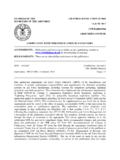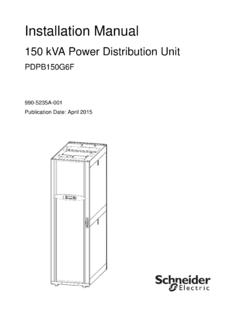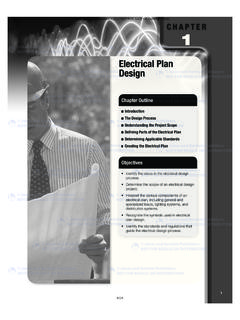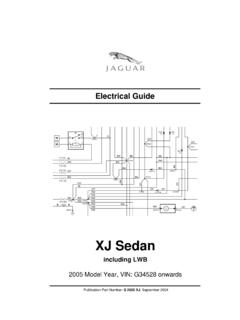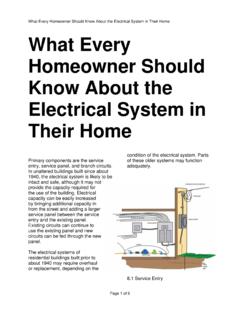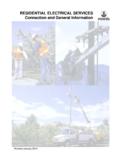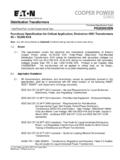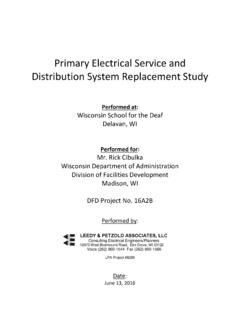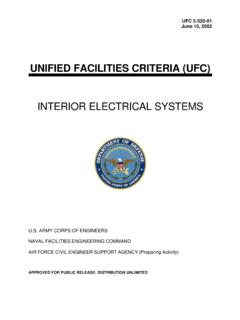Transcription of Basics in low voltage distribution equipment - eaton.com
1 Basics in low voltage distribution equipmentMark RumpelProduct line managerEaton Executive summaryDepending on their unique needs, multi-family, commercial and industrial sites typically rely upon either low or medium voltage service entrance equipment to control or cut off the electrical supply of their buildings from a single point. Low voltage distribution equipment typically operates at less than 600 volts; in contrast, medium voltage equipment affords a wider range of 600 to 38,000 paper provides a basic overview of the definitions, components, applications and other details associated with low voltage distribution equipment .
2 It covers electrical panelboards, switchboards and switchgear operating at 600 volts alternating current (AC) or direct current (DC) or below. The information is intended to help readers understand the purpose of electrical distribution systems and associated equipment and increase their technical knowledge about it. Basics of electricity generationIn the , as elsewhere, electricity has historically been generated from precious natural resources including coal, oil or natural gas. Nuclear energy and hydropower innovations advanced electrical generation capabilities at the end of the 20th century.
3 Today, alternative and renewable fuels such as geothermal energy, wind power , biomass and solar energy are gradually becoming more readily available; these sources are popular both for their higher efficiency and long-term harvested, natural resources and mechanical energy sources must first be converted into electrical energy to make it transmis-sible and usable. power plants complete this function using steam is heated in a massive boiler to produce steam, which is used to turn a series of blades mounted on a shaft turbine.
4 The force of the steam rotates a shaft connected to a generator. The spinning turbine shafts turn electromagnets surrounded by heavy coils of copper wire inside generators. This creates a magnetic field, which causes the electrons in the copper wire to move from atom to atom, thereby creating the turbines have generated electricity, voltage must be increased to transport it as power . This is accomplished by passing the electricity through a series of step-up transformers for routing onto a network of high voltage transmission lines.
5 electrical power then travels very efficiently and safely over long distances along these leadership White paperFigure 1. Understanding energy production and electrical distribution : from generation to transmission to distribution systems further facilitate the economic and safe delivery of adequate electrical power to all the electrical equipment used in a home, commercial building, or industrial facility. The transmitted power arrives first at an electric distribution substation, where it is passed through a series of step-down transformers that again lower the voltage to more usable levels.
6 Finally, the usable electricity enters the building at a single point known as the service entrance. power enters through a main device (circuit breaker or fusible switch) located within an electrical assembly referred to as the service entrance electrical distribution equipment . Panelboards, switchboards and switchgear can all be used as service entrance electrical distribution equipment or at a point downstream, in which case it is known simply as power distribution equipment . Each option offers unique uses and benefits to the multi-tenant home, commercial facility or industrial site, so it is helpful to consider each in greater detail.
7 PanelboardsA panelboard is a component of an electrical distribution system that divides an electrical power feed into branch circuits while providing a protective fuse or circuit breaker for each circuit in a common enclosure. In essence, panelboards are used to protect against electrical overloads and short circuits while distributing electricity throughout a building or main components of a panelboard typically include the enclosure, interior, circuit protection devices, labels, deadfront and trim, and filler 2.
8 Homeowners should be familiar with the basic components of commonly referred to as the box or can, the enclosure provides the housing in which all the other panelboard components reside. Enclosures are made of galvanized or painted steel to provide protection for personnel and internal equipment . Removable end panels allow for simple conduit installation where installers can easily locate and cut holes as the enclosure, overcurrent protection devices, busbars and other components are mounted on support rails. This interior assembly is commonly called a chassis.
9 Circuit breakers are commonly used as circuit protection devices and are connected to the busbars by bus connector busbar is a conductor used as a connection point for multiple circuits. Busbars are mounted to insulators on the interior rails, which are then mounted to studs inside the box. A neutral bar is also chassis- or gutter-mounted next to the interior, providing the termination point for the neutral wires from the incoming service and the load should always be well labeled. Labels provide regarding the unit s voltage rating, ampacity, interrupting rating, manufacturing date, panel vintage and renewal parts.
10 This information is critical to ensuring the safety of people and feature a front cover piece known as the panelboard s deadfront and trim. This component covers the front surface of the panelboard and provides a hinged access door that allows access to the circuit breakers while preventing contact with the energized interior components. Filler plates cover any unused pole spaces not occupied by a circuit National electrical Manufacturers Association (NEMA ) has established guidelines for electrical equipment enclosures.










